| Ebrechtella tricuspidata | |
|---|---|
 | |
| Ebrechtella tricuspidata. Male | |
 | |
| Female | |
| Scientific classification | |
| Domain: | Eukaryota |
| Kingdom: | Animalia |
| Phylum: | Arthropoda |
| Subphylum: | Chelicerata |
| Class: | Arachnida |
| Order: | Araneae |
| Infraorder: | Araneomorphae |
| Family: | Thomisidae |
| Genus: | Ebrechtella |
| Species: | E. tricuspidata |
| Binomial name | |
| Ebrechtella tricuspidata | |
| Synonyms | |
List
| |
Ebrechtella tricuspidata is a species of crab spiders belonging to the family Thomisidae. [2]



